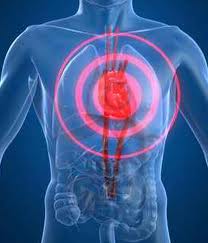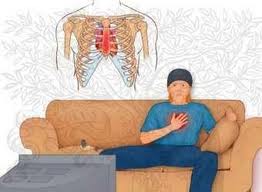Precordial Catch Syndrome Definition
Page Contents
- 1 Precordial Catch Syndrome Definition
- 2 Precordial Catch Syndrome ICD9 Code
- 3 Precordial Catch Syndrome Synonyms
- 4 Precordial Catch Syndrome Incidence
- 5 Precordial Catch Syndrome Causes
- 6 Precordial Catch Syndrome Symptoms
- 7 Precordial Catch Syndrome Diagnosis
- 8 Precordial Catch Syndrome Differential Diagnosis
- 9 Precordial Catch Syndrome Management
- 10 Precordial Catch Syndrome Treatment
- 11 Precordial Catch Syndrome Life Expectancy
- 12 Precordial Catch Syndrome Prevention
It is a harmless condition characterized by a sharp needle-like pain in the chest. The ache worsens while breathing heavily but does not last for more than 3 minutes. It is more prevalent among children and young adults. This type of illness is often mistaken for heart attack due to similar warning signs.
Precordial Catch Syndrome ICD9 Code
The ICD9 code for PCS is 786.51.
Precordial Catch Syndrome Synonyms
This medical condition is also referred to as:
Picture 1 – Precordial Catch Syndrome
- Texidor’s Twinge
- PCS
- Stitch in the slide
Precordial Catch Syndrome Incidence
This benign disorder generally affects children and young individuals. It is less likely to affect adults or aged people.
Precordial Catch Syndrome Causes
It refers to the sudden onset of pain on the left side of the chest, generally experienced by children. Usually short in duration, this type of pain does not spread out. The painful sensation which defines PCS is not conversional. The anxiety level in PCS patients increases with any kind of cardiac event. The pathology of the disease is not known. Pain may originate in the rib or cartilage area along with parietal pleura. The painful symptoms in PCS patients are not pericardial or cardiac in nature.
Precordial pain deteriorates with any kind of physical movement, even with inhalation and exhalation. This may disturb the normal activities of the day. Patients suffering from the syndrome try to breathe in a shallow manner in order to reduce the pain and wait for it to resolve on its own. The intensity of the pain may vary from one individual to other. In a few cases, sufferers experience a mild form of Precordial pain. 90% of affected individuals suffer from stabbing pain on the left side of the heart. The pain is usually very short-lived and intense.
Precordial Catch Syndrome Symptoms
Pain is the primary symptom of the disorder. The aches associated with PCS may range from intense to mild and may last for 3 minutes. Precordial pain becomes worse when the affected individual is lying down and occurs more than once in a week. People who have a sedentary lifestyle, or are generally inactive, are more prone to the syndrome. According to medical research, such patients display a few symptoms including:
- Pain upon movement
- Pain upon breathing
- Popping sensation when breathing deeply
- Sudden onset
- Localized pain
- Stabbing pain
- Pain lasting for 30 seconds to 3 minutes
- Aches, occurring even when a person is at rest
- Muscle spasm
- Anterior chest pain
- Dull pain
- Annoying pain
- Sharp pain
- Ripping feeling when breathing deeply
- Pricking pain
- Muscle cramps
- Pain, which is exacerbated through deep breathing
- Dull ache after the pain is gone
- Momentary visual loss
- Blurry vision
- Paresthesias
- Mild headedness
- Flushing
- Palpitations
- Shallow breathing
- Sudden resolution
- Complete resolution
- No other abnormal physical findings
- Pallor
- Syncope
- Near syncope
Precordial Catch Syndrome Diagnosis
People experiencing PCS are required to be reassured that the condition is benign in nature unless it is linked with other disorders. Appropriate diagnosis of PCS is essential in order to prevent the patient from getting tensed and to provide him/her with apt treatment. The diagnostic evaluation of the syndrome should initiate with careful examination of the medical history of the patient. The referring physician should carefully consider the medical history of the sufferer to determine the diagnostic features of the disorder. Although the diagnosis is generally based on the patient’s history, a detailed physical examination is essential in order to rule out other possible reasons for the chest pain.
Diagnostic testing is rarely required for PCS patients and it often gives rise to anxiety. A few ancillary tests are often recommended by doctors to have a better diagnosis. Such exams include:
- Echocardiography
- Electrocardiography
- Radiography
- Barium studies
Precordial Catch Syndrome Differential Diagnosis
The differential diagnosis of PCS involves ensuring that the symptoms are not the result of pulmonary, cardiac, chest-wall and gastrointestinal pain. This can easily be distinguished on the basis of its characteristics. Other than PCS, a number of other painful disorders also cause pain in the chest wall of a patient. The costosternal joints in the body of a sufferer are prone to various other ailments, including:
- Rheumatoid arthritis
- Reiter’s syndrome
- Osteoarthritis
- Ankylosing spondylitis
- Psoriatic arthritis
Precordial Catch Syndrome Management
The primary step for the management of PCS disorder includes careful observation of a patient and thorough discussion with the doctor. The sole purpose of the discussion is to make sure that the family of the affected patient does not panic and take the disorder seriously. The concerned physician must begin to assure the families by making them believe that chest pain among children is quite common these days. A detailed discussion on the occurring symptoms of the patient along with the features which distinguish it from other cardiac pain disorders is very essential.
Precordial Catch Syndrome Treatment
On the basis of the diagnostic evaluation, PCS can be treated by following a few simple steps which include:
Picture 2 – Precordial Catch Syndrome Image
- Lying down on the bed with the face in a downward position
- Breathing in a very shallow manner whenever the pain occurs
- Sudden deep breathing, which reduces the muscle spasm
Any form of drug or medication is not required to provide relieve to PCS patients, since the disorder is short-lived to a maximum of 3 minutes. Proper diagnosis eliminates the fear of the disorder from the mind of a patient. It is quite uncertain whether PCS or not will affect the regular activities.
Precordial Catch Syndrome Life Expectancy
Such disorders are benign in nature and do not imply any form of danger to a teenager or child. Although the symptoms appear very rapidly, they resolve at a much faster rate. Thus, medical practitioners conclude that PCS does not have any life expectancy. Life expectancy tends to depend on the individual life style and the existing condition of the patient.
Precordial Catch Syndrome Prevention
People having a sedentary lifestyle are more susceptible to the disorder. Hence, in order to avoid the occurring symptoms of the disorder, a healthy and active lifestyle is highly recommended. Patients affected with PCS must be aware of the fact that the disorder is momentary and resolves with time. Hence, there is no need to panic.
Although PCS is not a serious disorder, it is necessary to consult your health care provider immediately if your child is suffering from frequent pain on the left side of the chest or arm that persists even after 24 hours. Do not panic, for this disorder is benign in nature.
References:
http://en.wikipedia.org/wiki/Precordial_catch_syndrome
http://www.precordialcatchsyndrome.org/
http://journals.lww.com/smajournalonline/Fulltext/2003/01000/Precordial_Catch_Syndrome.11.aspx
http://syndromespedia.com/precordial-catch-syndrome-treatment-symptoms-causes.html


